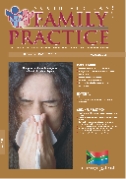Prostate Cancer Management - Helping Your Patient Choose What is Best for Him
Keywords:
prostate cancer, urology
Abstract
The biggest problems in prostate cancer management are how to identify patients with potentially life-threatening cancer, and how to choose the best form of management from among the large array of treatment options. Although prostate cancer is the second or third most common cause of cancer death in males, most men with this diagnosis will die of other causes. The most important prognostic factors are the patient’s life expectancy, the grade and stage of the tumour and the serum prostate specific antigen (PSA) at diagnosis. The most important management options are (1) active surveillance (watchful waiting), (2) androgen deprivation therapy (ADT), (3) radical prostatectomy and (4) radiotherapy. Patients with a limited life expectancy or non-aggressive cancer can be managed with active surveillance and be treated only if and when it becomes necessary. ADT (hormone therapy) provides excellent palliation in men with locally advanced or metastatic cancer, but the side-effects decrease quality of life. Radical prostatectomy and radiotherapy are potentially curative if the cancer is localised to the prostate. The use of laparoscopic radical prostatectomy is increasing in affluent countries, although (apart from reduced blood loss) there are no significant advantages compared to retropubic or perineal radical prostatectomy. The main complications are erectile dysfunction and urinary incontinence. The use of brachytherapy is increasing, although there is no convincing evidence that it is more effective or has fewer complications than external beam radiotherapy. Although a vast amount of information on prostate cancer is available on the internet, some of the websites are driven by financial incentives to promote their products or procedures, and patients may emerge with unrealistic expectations based on misinformation. There are certain websites, based on the Partin tables or the Kattan nomogram, which can be used by the doctor to calculate the patient’s statistical probability of being cured with radical prostatectomy or radiotherapy. The probability of cure has to be weighed up against the risk of complications or side-effects that impair quality of life. There are very few randomised clinical trials comparing treatment options, so there is no real answer to the question which form of management is “best”. Patients and their families should be given comprehensive and unbiased information and sufficient time to make decisions. Because there are no absolutely right or wrong choices, and because patients all have different expectations, it is best for the patient himself to decide what form of management would be best for him.
Section
CPD
By submitting manuscripts to SAFP, authors of original articles are assigning copyright to the South African Academy of Family Physicians. Copyright of review articles are assigned to the Publisher, Medpharm Publications (Pty) Ltd, unless otherwise specified. Authors may use their own work after publication without written permission, provided they acknowledge the original source. Individuals and academic institutions may freely copy and distribute articles published in SAFP for educational and research purposes without obtaining permission.

